Computing the speed of repayment of loans
1 - Introduction
Credit Risk refers to the likelihood that a borrower will not be able to repay a loan contracted by a lender. Thus throughout the years, financial institutions have developed various ways to quantify that risk so as to limit their exposure.
Here, instead of simply modeling whether a borrower will repay, by using Survival Analysis, it becomes possible to determine when this will happen. Indeed, it is easy to consider that fully repaying a loan is an explicit event, and therefore not having paid back the loan yet can be defined as the censored situation.
By using this configuration, banks, credit unions, or fintech startups in the lending space can predict the speed of repayment of a loan. This will help these institutions mitigate losses due to bad debt, customize interest rates, improve cash flow and credit collections, and determine which customers are likely to bring in the most revenue throughout a variety of products.
2 - Set up
In this tutorial, we will be using the German Credit dataset, which was originally provided by Professor Dr. Hans Hofmann of the University of Hamburg and available on the UCI Machine Learning Repository. The current version was adapted to be directly usable with a minimum amount of feature transformation..
3 - Dataset
3.1 - Overview
The dataset contains information useful to assess the borrowers creditworthiness as well as socio-demographic elements:
| Feature category | Feature name | Type | Description |
|---|---|---|---|
| Time | duration |
numerical | Duration in month |
| Event | full_repaid |
categorical | Specifies if the loan was fully repaid |
| Socio-Demographic | age |
numerical | Age of the borrower (in years) |
| Socio-Demographic | foreign_worker |
numerical | Indicates if the borrower is a foreign worker |
| Socio-Demographic | personal_status |
categorical | Gender and Marital status |
| Socio-Demographic | people_liable |
numerical | Number of people being liable to provide maintenance for |
| Socio-Demographic | telephone |
numerical | Indicates if the borrower owns a phone |
| Employment | employment_years |
categorical | Years of employment at current job |
| Employment | job |
categorical | Employment status |
| Residence | housing |
categorical | Residential status of the borrower |
| Residence | present_residence |
numerical | Years living at current residence |
| Loan information | amount |
numerical | Amount of money borrowed |
| Loan information | installment_rate |
numerical | Percentage of amount borrowed that will be charged by a lender to a borrower. |
| Loan information | purpose |
categorical | Reason to get a loan |
| Bank information | checking_account_status |
categorical | Status of the checking account |
| Bank information | credit_history |
categorical | Credit history of the borrower |
| Bank information | number_of_credits |
numerical | Number of existing credits at this bank |
| Bank information | other_installment_plans |
categorical | Type of installments plans the borrower already has |
| Bank information | savings_account_status |
categorical | Status of the saving account |
| Collateral/Guarantor | property |
categorical | Type of valuable assets the borrower owns |
| Collateral/Guarantor | other_debtors |
categorical | Indicate if someone else will be involved in the repayment or is guaranteeing the loan |
# Importing modules import pandas as pd import numpy as np from matplotlib import pyplot as plt from pysurvival.datasets import Dataset %pylab inline # Reading the dataset raw_dataset = Dataset('credit_risk').load() print("The raw_dataset has the following shape: {}.".format(raw_dataset.shape)) raw_dataset.head(3)
| checking_account_status | duration | credit_history | ... | foreign_worker | full_repaid |
|---|---|---|---|---|---|
| below_0 | 6 | critical_account | ... | 1 | 1 |
| 0_to_200 | 48 | existing_credit_paid | ... | 1 | 0 |
| no_account | 12 | critical_account | ... | 1 | 1 |
3.2 - From categorical to numerical
There are several categorical features that need to encoded into one-hot vectors:
# From category to numerical category_columns = [ 'checking_account_status', 'credit_history', 'purpose', 'savings_account_status', 'employment_years', 'personal_status', 'other_debtors', 'property', 'other_installment_plans', 'housing', 'job'] dataset = pd.get_dummies(raw_dataset, columns=category_columns, drop_first=True) # Creating the time and event columns time_column = 'duration' event_column = 'full_repaid' # Creating the features features = np.setdiff1d(dataset.columns, [time_column, event_column] ).tolist()
4 - Exploratory Data Analysis
As this tutorial is mainly designed to provide an example of how to use PySurvival, we will not do a thorough exploratory data analysis here but greatly encourage the reader to do so by checking the predictive maintenance tutorial that provides a detailed analysis.
Here, we will just check if the dataset contains Null values or if it has duplicated rows. Then, we will take a look at feature correlations.
4.1 - Null values and duplicates
The first thing to do is checking if the raw_dataset contains Null values and has duplicated rows.
# Checking for null values N_null = sum(dataset[features].isnull().sum()) print("The raw_dataset contains {} null values".format(N_null)) #0 null values # Removing duplicates if there exist N_dupli = sum(dataset.duplicated(keep='first')) dataset = dataset.drop_duplicates(keep='first').reset_index(drop=True) print("The raw_dataset contains {} duplicates".format(N_dupli)) # Number of samples in the dataset N = dataset.shape[0]
4.2 - Correlations
Let's compute and visualize the correlation between the features
from pysurvival.utils.display import correlation_matrix correlation_matrix(dataset[features], figure_size=(40,15), text_fontsize=7)
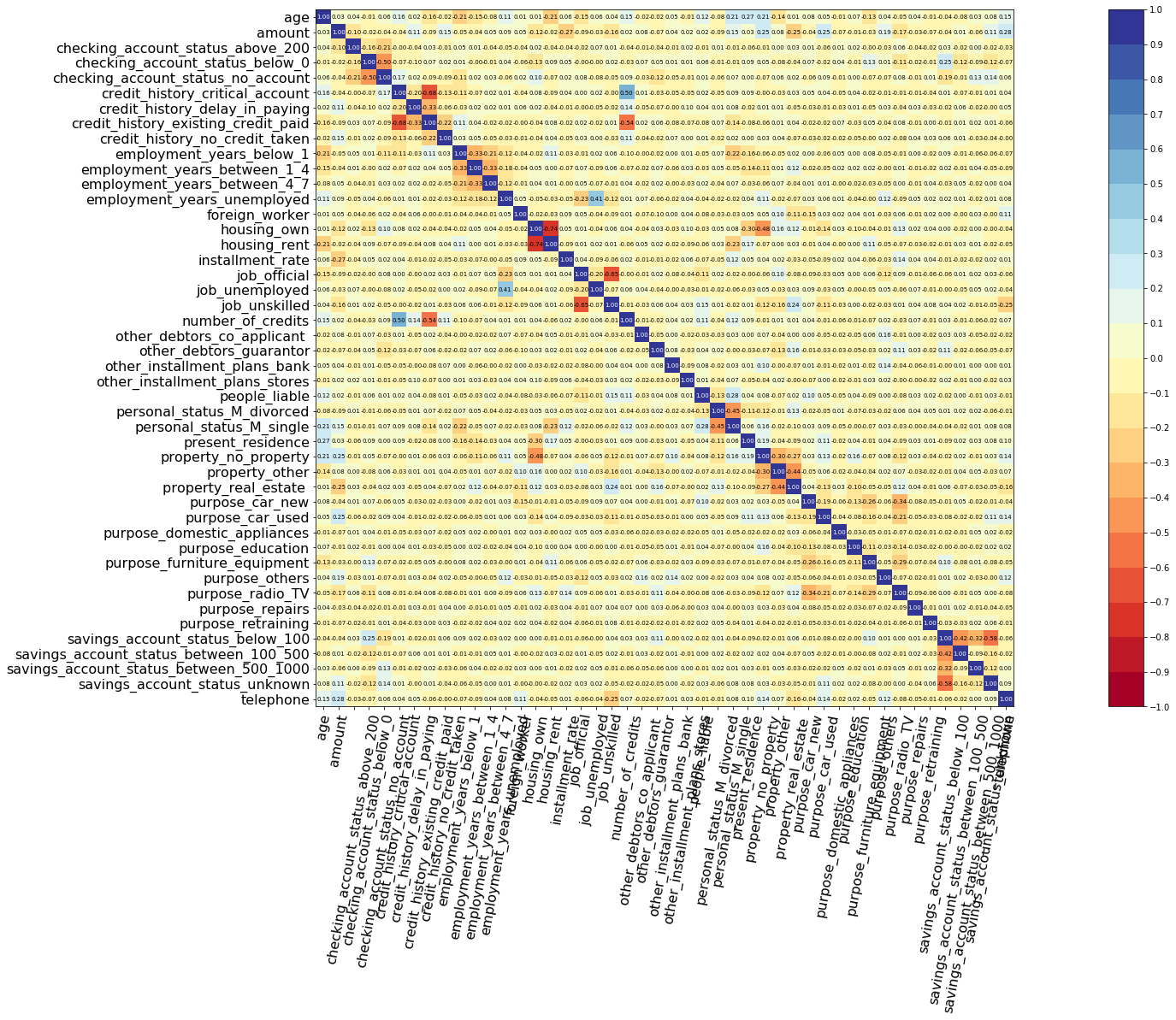
Based on the correlations chart, we should remove the following features
credit_history_existing_credit_paidhousing_own
to_remove = ['credit_history_existing_credit_paid', 'housing_own'] features = np.setdiff1d(features, to_remove).tolist()
5 - Modeling
So as to perform cross-validation later on and assess the performances of the model, let's split the dataset into training and testing sets.
# Building training and testing sets from sklearn.model_selection import train_test_split index_train, index_test = train_test_split( range(N), test_size = 0.4) data_train = dataset.loc[index_train].reset_index( drop = True ) data_test = dataset.loc[index_test].reset_index( drop = True ) # Creating the X, T and E inputs X_train, X_test = data_train[features], data_test[features] T_train, T_test = data_train[time_column], data_test[time_column] E_train, E_test = data_train[event_column], data_test[event_column]
Let's now fit a Neural MTLR model to the training set.
Note: The choice of the structure of the neural network was obtained using grid-search hyperparameters selection, not displayed in this tutorial.
from pysurvival.models.multi_task import NeuralMultiTaskModel # Initializing the Neural MTLR with a time axis split into 100 intervals structure = [ {'activation': 'ReLU', 'num_units': 60}, {'activation': 'Swish', 'num_units': 60}, ] neural_mtlr = NeuralMultiTaskModel(bins=100, structure=structure) # Fitting the model neural_mtlr.fit(X_train, T_train, E_train, init_method = 'orthogonal', optimizer ='rprop', lr = 1e-4, l2_reg = 1e-1, l2_smooth = 1e-1, batch_normalization = True, bn_and_dropout = True, dropout=0.5, num_epochs = 500)
We can take a look at the values of N-MTLR loss function to ensure that the fitting isn't incomplete
from pysurvival.utils.display import display_loss_values display_loss_values(neural_mtlr)

6 - Cross Validation
In order to assess the model performance, we previously split the original dataset into training and testing sets, so that we can now compute its performance metrics on the testing set:
6.1 - C-index
The C-index represents the global assessment of the model discrimination power: this is the model’s ability to correctly provide a reliable ranking of the survival times based on the individual risk scores. In general, when the C-index is close to 1, the model has an almost perfect discriminatory power; but if it is close to 0.5, it has no ability to discriminate between low and high risk subjects.
from pysurvival.utils.metrics import concordance_index c_index = concordance_index(neural_mtlr, X_test, T_test, E_test) print('C-index: {:.2f}'.format(c_index)) #0.76
6.2 - Brier Score
The Brier score measures the average discrepancies between the status and the estimated probabilities at a given time. Thus, the lower the score (usually below 0.25), the better the predictive performance. To assess the overall error measure across multiple time points, the Integrated Brier Score (IBS) is usually computed as well.
from pysurvival.utils.display import integrated_brier_score integrated_brier_score(neural_mtlr, X_test, T_test, E_test, t_max=100, figure_size=(20, 6.5) ) #0.08
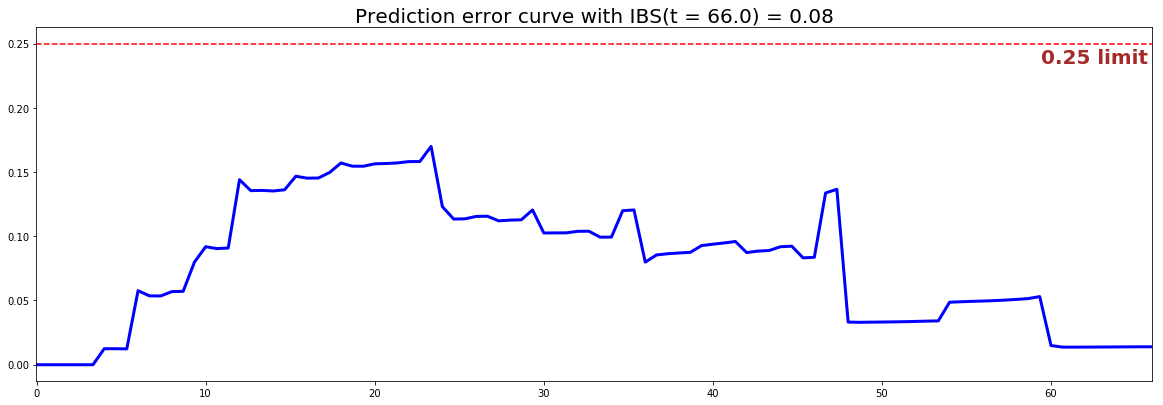
The IBS is equal to on the entire model time axis. This indicates that the model will have good predictive abilities.
7 - Predictions
7.1 - Overall predictions
Now that we have built a model that seems to provide great performances, let's compare the following:
- the time series of the actual and predicted number of loans that were fully repaid, for each time t.
from pysurvival.utils.display import compare_to_actual results = compare_to_actual(neural_mtlr, X_test, T_test, E_test, is_at_risk = False, figure_size=(16, 6), metrics = ['rmse', 'mean', 'median'])
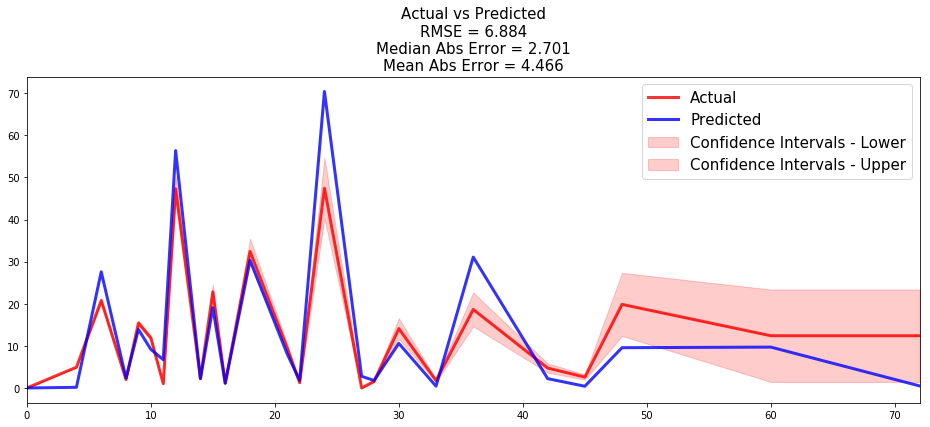
- the time series of the actual and predicted number of loans that were still active, for each time t.
results = compare_to_actual(neural_mtlr, X_test, T_test, E_test, is_at_risk = True, figure_size=(16, 6), metrics = ['rmse', 'mean', 'median'])
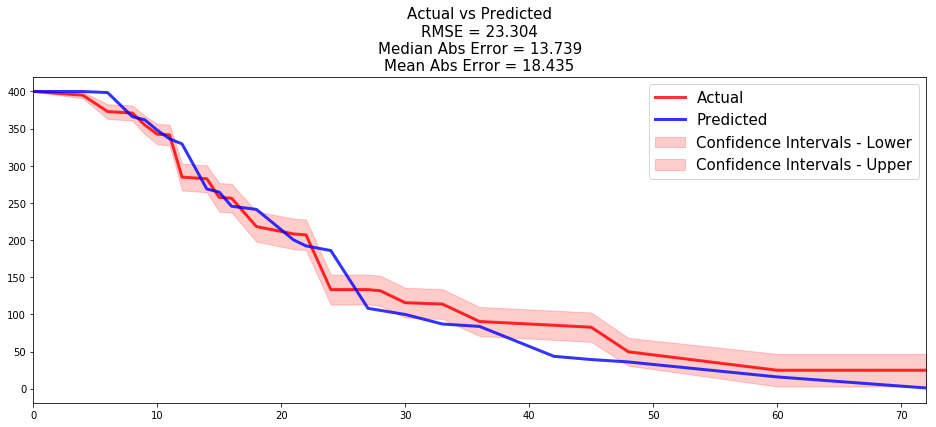
Both comparisons show that the model do a great job predicting the number of loans that were fully repaid (average absolute error of 4.5 loan) or that were still active (average absolute error of 18.4 loans) for all times t of the 70+ months time window.
7.2 - Individual predictions
Now that we know that we can provide reliable predictions for an entire cohort, let's compute the speed of repayment at the individual level. The speed of repayment is given by
First, we can construct the risk groups based on risk scores distribution. The helper function create_risk_groups, which can be found in pysurvival.utils, will help us do that:
from pysurvival.utils.display import create_risk_groups risk_groups = create_risk_groups(model=neural_mtlr, X=X_test, use_log = True, num_bins=30, figure_size=(20, 4), low= {'lower_bound':0, 'upper_bound':1.64, 'color':'red'}, medium= {'lower_bound': 1.64, 'upper_bound':1.8, 'color':'green'}, high= {'lower_bound':1.8, 'upper_bound':3, 'color':'blue'} )

Note: The current choice of the lower and upper bounds for each group is based on my intuition; so feel free to change the values so as to match your situation instead.
Here, it is possible to distinguish 3 main groups, low, medium and high risk groups. Because the C-index is high, the model will be able to rank the survival times of a random unit of each group, such that .
Let's randomly select individual unit in each group and compare their speed of repayment functions. To demonstrate our point, we will purposely select units which experienced an event to visualize the actual time of event.
# Initializing the figure fig, ax = plt.subplots(figsize=(15, 5)) # Selecting a random individual that experienced an event from each group groups = [] for i, (label, (color, indexes)) in enumerate(risk_groups.items()) : # Selecting the individuals that belong to this group if len(indexes) == 0 : continue X = X_test.values[indexes, :] T = T_test.values[indexes] E = E_test.values[indexes] # Randomly extracting an individual that experienced an event choices = np.argwhere((E==1.)).flatten() if len(choices) == 0 : continue k = np.random.choice( choices, 1)[0] # Saving the time of event t = T[k] # Computing the CDF for all times t cdf = 1. - neural_mtlr.predict_survival(X[k, :]).flatten() # Displaying the functions label_ = '{} risk'.format(label) plt.plot(neural_mtlr.times, cdf, color = color, label=label_, lw=2) groups.append(label) # Actual time plt.axvline(x=t, color=color, ls ='--') ax.annotate('T={:.1f}'.format(t), xy=(t, 0.5*(1.+0.2*i)), xytext=(t, 0.5*(1.+0.2*i)), fontsize=12) # Show everything groups_str = ', '.join(groups) title = "Comparing cumulative density functions between {} risk grades" title = title.format(groups_str) plt.legend(fontsize=12) plt.title(title, fontsize=15) plt.xlim(0, 65) plt.ylim(0, 1.05) plt.show()
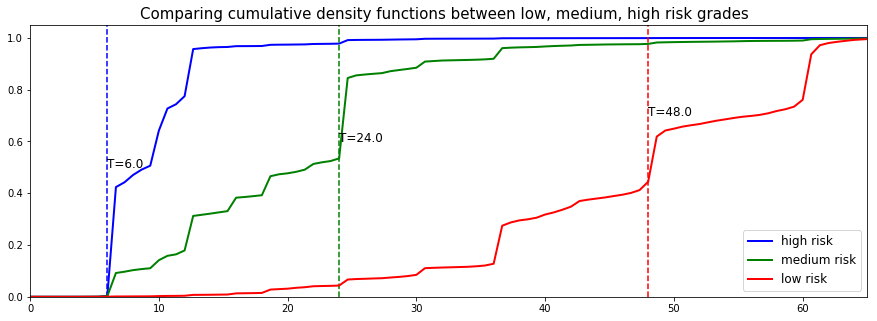
As we can see, the model manages to perfectly predict the event time, here it corresponds to a sudden increase in the individual speed of repayment function.
8 - Conclusion
We can now save our model so as to put it in production and score future borrowers.
# Let's now save our model from pysurvival.utils import save_model save_model(neural_mtlr, '/Users/xxx/Desktop/credit_neural_mtlr.zip')
Thanks to Survival Analysis, we can see that it is indeed possible to predict the speed of repayment of loans and forecast the number of loans that will be fully repaid throughout time, which is a great advantage over classification modeling.